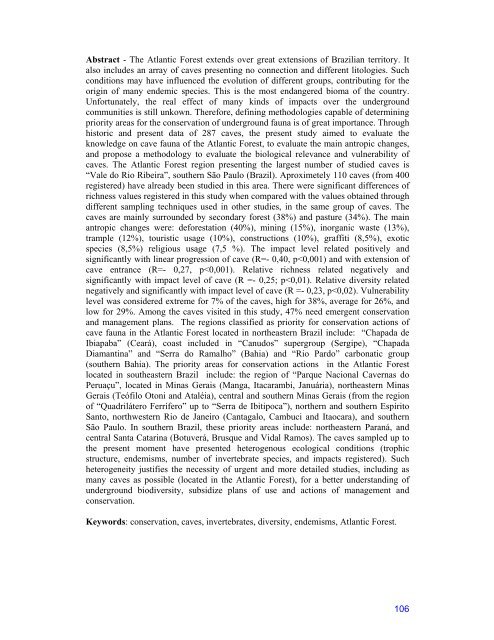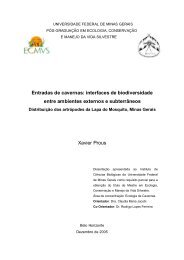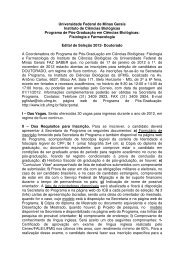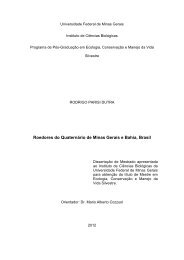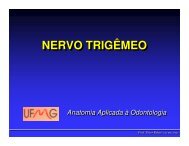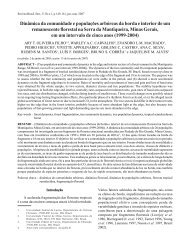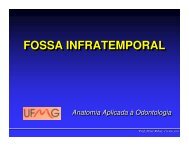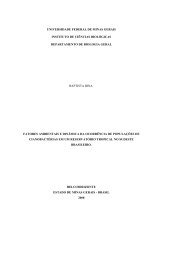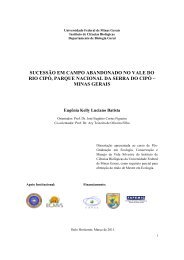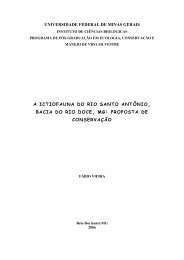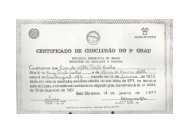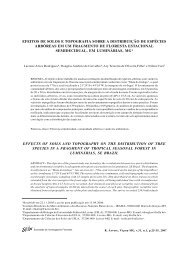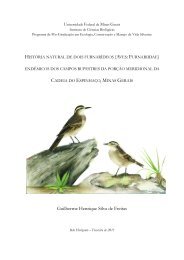- Page 1 and 2:
UNINERSIDADE FEDERAL DE MINAS GERAI
- Page 3 and 4:
DEDICATÓRIA2
- Page 5 and 6:
RJ que nos forneceu a senha para a
- Page 7 and 8:
SUMÁRIOAPRESENTAÇÃO ............
- Page 9 and 10:
APRESENTAÇÃOMuitas áreas em vár
- Page 11 and 12:
arenitos) e ferruginosas (inseridas
- Page 13 and 14:
ecentes, 20 mil anos (Silva & Caste
- Page 15 and 16:
No Brasil há aproximadamente 5000
- Page 17 and 18:
esponsáveis pela importação de r
- Page 19 and 20:
Paraná (Trajano 1987, Gnaspini-Net
- Page 21 and 22:
Culver & Sket 2000, Sessegolo et al
- Page 23 and 24:
Figura 1. Regiões cársticas carbo
- Page 25 and 26:
Figura 3 - Corredores de Biodiversi
- Page 27 and 28:
Resumo - A fauna cavernícola brasi
- Page 29 and 30:
INTRODUÇÃOCaracterísticas ecoló
- Page 31 and 32:
fauna cavernícola na Mata Atlânti
- Page 33 and 34:
possível. Cada táxon foi separado
- Page 35 and 36:
dominância de Berger-Parker foi ut
- Page 37 and 38:
Cyphoderidae, Entomobryiidae), Dipl
- Page 39 and 40:
(1sp.), Anthozoa (1 sp.), Cirripedi
- Page 41 and 42:
estudadas), a Chapada Diamantina, n
- Page 43 and 44:
Tabela 1. Lista das espécies que a
- Page 45 and 46:
Trechini sp3 1 +Trechini spe 1 +Col
- Page 47 and 48:
Figura 3. Curva acumulativa de morf
- Page 49 and 50:
Figura 5. Variações na diversidad
- Page 51 and 52:
1201201001008080Riqueza60Riqueza604
- Page 53 and 54:
predadores generalistas, possibilit
- Page 55 and 56:
onde a autora coletou intensamente
- Page 57 and 58:
equívocos podem ser desastrosos, j
- Page 59 and 60:
quando não há troca de genes com
- Page 61 and 62:
se abrigarem, durante o dia, em mic
- Page 63 and 64: cavernas quartzíticas nas montanha
- Page 65 and 66: A relação de aumento da riqueza c
- Page 67 and 68: REFERÊNCIAS BIBLIOGRÁFICASAndrade
- Page 69 and 70: Galindo, L. C. & Câmara, I. G. 200
- Page 71 and 72: Sharratt, N. J., M. Picker & M. Sam
- Page 73 and 74: Resumo - No Brasil, somente caverna
- Page 75 and 76: INTRODUÇÃORochas base e a formaç
- Page 77 and 78: grânulos de material desabado do t
- Page 79 and 80: megadiversidade e em um hotspot de
- Page 81 and 82: Figura 1 - Domínios da Mata Atlân
- Page 83 and 84: hidrologia e vegetação no entorno
- Page 85 and 86: 2,62,42,22,01,8Riqueza Relativa1,61
- Page 87 and 88: Estrutura das comunidades de invert
- Page 89 and 90: 1,4Riqueza relativa (ferruginosa)1,
- Page 91 and 92: Figura 7. Variações na ocorrênci
- Page 93 and 94: 600Abundância relativa (carbonáti
- Page 95 and 96: 3,0Riqueza relativa (carbonática)2
- Page 97 and 98: litologias. A singularidade da estr
- Page 99 and 100: invertebrados. Entretanto, outro fa
- Page 101 and 102: claramente distintas, tendo em vist
- Page 103 and 104: mesmo aos ventos mais intensos que
- Page 105 and 106: icas estarem associadas a riachos m
- Page 107 and 108: Maiores riquezas, abundâncias e di
- Page 109 and 110: REFERÊNCIAS BIBLIOGRÁFICASArechav
- Page 111 and 112: Romero A. & M. Green 2005. The end
- Page 113: Resumo - A Mata Atlântica ocupa gr
- Page 117 and 118: mostrado altamente heterogênea ent
- Page 119 and 120: Área de estudoMETODOLOGIAPara real
- Page 121 and 122: Ubajara) e São Paulo (gruta do qua
- Page 123 and 124: Cavernas com riqueza total alta rec
- Page 125 and 126: tênue (e.g. os recursos tróficos
- Page 127 and 128: (baixo grau de impactos); 6-10 pont
- Page 129 and 130: insuficiência de conhecimento e gr
- Page 131 and 132: fauna foram realizadas em cavernas
- Page 133 and 134: Alterações antrópicas nas cavern
- Page 135 and 136: Ferruginosas% de cavernas40%35%30%2
- Page 137 and 138: Relevâncias biológicas, impactos
- Page 139 and 140: Figura 8. Mapa representando o grau
- Page 141 and 142: Figura 10. Vulnerabilidade das comu
- Page 143 and 144: A região da Chapada de Ibiapada, N
- Page 145 and 146: endemismos e impactos do turismo ne
- Page 147 and 148: Ouro Preto/Luminárias/Carrancas/Li
- Page 149 and 150: Cavernas cadastradas pelo CECAV/IBA
- Page 151 and 152: Cavernas cadastradas pelo CECAV/IBA
- Page 153 and 154: cavernas. Além disto, a quantidade
- Page 155 and 156: principal componente dos ecótones
- Page 157 and 158: Alterações antrópicas nas cavern
- Page 159 and 160: Tal fato pode ser visualizado nas r
- Page 161 and 162: Por outro lado, as cavernas em roch
- Page 163 and 164: principalmente aquelas turísticas;
- Page 165 and 166:
A alta vulnerabilidade encontrada p
- Page 167 and 168:
de cavernas presentes na Mata Atlâ
- Page 169 and 170:
desmatamento do entorno, retirada d
- Page 171 and 172:
REFERÊNCIAS BIBLIOGRAFICASAuler A.
- Page 173 and 174:
Lourenço, Wilson R., R.L.C. Baptis
- Page 175 and 176:
CAPÍTULO IVA AVENTURA DA VIDA NAS
- Page 177 and 178:
Neste contexto, é apresentado abai
- Page 179 and 180:
171
- Page 181 and 182:
173
- Page 183 and 184:
175
- Page 185 and 186:
177
- Page 187 and 188:
179
- Page 189 and 190:
181
- Page 191 and 192:
183
- Page 193 and 194:
185
- Page 195 and 196:
187
- Page 197 and 198:
189
- Page 199 and 200:
191
- Page 201 and 202:
193
- Page 203 and 204:
195
- Page 205 and 206:
197
- Page 207 and 208:
Bichuette, M. E.; Trajano, E. 2003.
- Page 209 and 210:
Ferreira, R.L. & Horta, L.C.S. 2001
- Page 211 and 212:
Lobo, H. A. S. 2008. Ecoturismo e p
- Page 213 and 214:
Samways, M. J. 2005. Insect diversi
- Page 215 and 216:
ANEXOSAnexo I. Ficha de caracteriza
- Page 217 and 218:
ES Casa Branca Itaimbe- itaguaçu 1
- Page 219 and 220:
MG Gruta do Rio Suaçui Santa Maria
- Page 221 and 222:
PR-132 Abismo do Leão Adrianópoli
- Page 223 and 224:
SP-260 Gruta do Floido Iporanga Sim
- Page 225 and 226:
217


